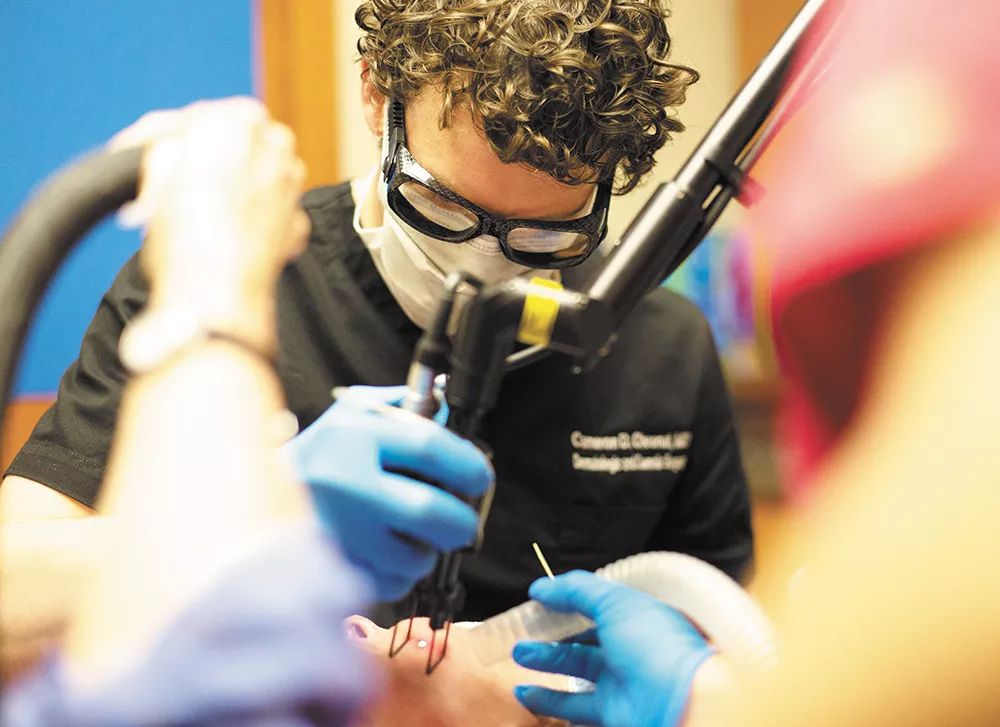
"Did you color your hair? Change your makeup? You look so.... rested." You smile, not smugly you hope, and graciously accept the compliment. Maybe you'll divulge that you recently had a cosmetic procedure, maybe not. The results are so subtle even your husband or your best friend probably won't realize you've had "work" done.
Welcome to the New Age of fillers, injectables, lasers and the myriad of non-surgical treatments. Technology and medical knowledge of how the body ages has propelled cosmetic surgery away from the slice-and-pull of facelifts into a new era of less invasive procedures that are often performed with local or topical anesthesia and come with considerably shorter healing time.
"We know now it's not just skin that is aging but a combination of skin, fat, bone and muscle," says Cameron Chesnut, MD, a board certified and fellowship-trained cosmetic surgeon at Dermatology Specialists of Spokane. "The face is like a bed. You have the frame — the bones; the mattress— the soft tissue; and the bedspread — the skin. You can smooth the wrinkles out of the bedspread, but if there's a weakened and diminished bed frame or a big dip in the mattress, you will never be able to hide it with a bedspread alone."
Today dozens of procedures are available to plump, fill, volumize, freeze or relax the wrinkles, bags, sags, spots or dips on your face, neck or décolletage. Often called lunchtime lifts, many take only 30 to 60 minutes and are performed in the physician's office. Injections, lasers and dermabrasion can sting or burn, but most patients report minimal discomfort. Healing is much faster than traditional facelifts and takes from a few hours to a few weeks.
Thinking about a procedure?
Abraham Lincoln said you get the face you deserve at 40; George Orwell upped it a decade to 50. Smoking, sun, frowning, smiling, genetics, free radicals — in short, life — all eventually show up on your face no matter how much sunscreen and lotions you've used.
Some people start cosmetic treatments as young as 30, but usually around 40 years of age, women — and a few men — look into the mirror and wonder how they got so old, or tired, or speckled. Physicians report that most of their patients are in their late-30s to mid-50s.
Chesnut, who completed his plastic surgery fellowship at the University of California, Los Angeles, says there is a noticeable contrast in what people were looking for in California and what they want in the Northwest. "In L.A., it's a status symbol to look like you've had work done," he says. "Up here, patients want subtle changes."
What to expect
Cosmetic surgery and procedures will not take 20 years off your face. They won't save your marriage or land a job. They will not make you gorgeous if you aren't already a stunner.
But new procedures can give you a refreshed, rested look; lighten sun spots; de-puff eyes; reduce a baggy chin; brighten skin; and diminish crow's feet, smile lines and other pesky wrinkles. Notice we have not used the words "erase" or "remove." Disappearing acts are rarely possible, even with today's advances in procedures.
And cosmetic procedures are seldom a once-in-a-lifetime affair. The rate at which your skin ages and the treatment you choose determine how often you'll be back, but expect to see your specialist every six to 12 months to keep up your new look. And be prepared to write some big checks: Procedures can run in the thousands of dollars.
Is it worth it?
When Marcia Kramer's 65th birthday approached, she decided it was time to do something about sun spots and a saggy chin. "I'm an outdoorsy girl — I ski, hike, bike — and all those years in the sun were showing. And that wobbly chin! They don't make a chin bra, you know. It had to go."
Not an impulsive woman, Kramer researched procedures and results. She had relatives who had had facelifts, and witnessed their pain and lengthy healing and knew she didn't want to go that route. She chose Smart Skin Fractionated CO2 for her face and Precision Tx Cynosure for her lower face and neck. In layman's terms, that's laser treatments and liposuction.
"Was it worth it? Definitely!" Kramer says. "I wasn't trying to look 30. I wanted to look brighter, healthier, and I think I do."
On the other hand, 50-something Janet, who prefers we not use her last name, is not as enthusiastic. A year ago, she had Botox to diminish frown lines and laser skin rejuvenation to even out her skin tone.
"The Botox definitely froze the frown lines in my forehead, and I saw some improvement with skin resurfacing," she says. "But really, I didn't see enough change to justify the expense. I don't think I'll have any more treatments done."
The maze of providers
Would you see an oral surgeon if you had bunions? An orthopedist if you were pregnant? Definitely not. They're both doctors and they all know about human anatomy, but each is trained and certified in a different specialty. Your face is special, so choose who works on it carefully.
"The Wild West cosmetic atmosphere of Spokane has been changing recently, as consumers have become more sophisticated and raised their cosmetic IQ," says Chesnut. "A solid group of fellowship-trained cosmetic surgeons now exists in our community. "

A little insight into the process can be helpful for potential patients. "Board certification" means the physician has been trained beyond medical school and residency in a specific field. In the case of cosmetic surgery, the "core four" cosmetic specialties are dermatologic surgery, oculoplastic surgery, facial plastic surgery or plastic surgery.
"Cosmetic surgery" per se is not a specialty. There is a Cosmetic Surgery Society, but they do not require additional training or a fellowship.
Complicating matters are the dozens of societies, associations, boards and academies related to cosmetic surgery. Some, like the American Academy of Facial Plastic and Reconstructive Surgery, the American Society of Plastic Surgeons, the American Academy of Dermatology, and American Society of Oculoplastic and Reconstructive Surgery, have rigorous admittance standards; others are so relaxed they require only yearly dues. Keep in mind it is possible for a provider to become certified in some cosmetic procedures simply by attending a seminar or training program hosted by a vendor.
So do your homework before submitting to a procedure. Find out how long the physician has been practicing and how many procedures they have performed. Verify the surgeon's board certification, education and license with the state's medical board and check whether disciplinary action has been taken against him or her.
Personal recommendations are valuable, too, so ask friends who have worked with a cosmetic surgeon for referrals. Get feedback from your family doctor and other medical acquaintances.
At your interview/consultation, the physician should ask about your goals and expectations. If he or she thinks your expectations are unrealistic, do not run out the door. You need honest feedback from a professional in order to make good choices.
"When a patient comes in to interview me, I first ask what's bothering them most," says Joel Sears, MD, of Advanced Dermatology. "There are so many tools available to improve looks or give someone a fresher appearance, but there are also limits to what we can accomplish. We don't want patients to be disappointed, but we don't push procedures on them either. 'Never, never overdo' is my motto."
The physician will suggest the most appropriate procedure, show you before-and-after photos of patients, tell you where the procedure will be performed, how long it will take, and what immediate aftereffects to expect. He or she will give you a treatment plan and outline costs. Since cosmetic surgery is elective, your insurance will not cover it.
Future faces
The past decade has brought us cosmetic fillers that last longer and have fewer side effects, along with new procedures that use light and lasers. A needle-free, topical Botox successor is undergoing clinical trials and seeking FDA approval.
"Going forward into the future, we will continue to see procedures moving toward being less invasive in terms of shorter downtime and less risk," says Wm. Philip Werschler, MD, of Spokane Dermatology Clinic. "For example, Ultherapy is an FDA-approved procedure for face lifting that has minimal to no downtime."
You may feel like a kid in a candy shop with all of these choices in front of you. Or you may weigh the pros and cons, costs and probable results, and decide not to have any cosmetic procedures. Some women are comfortable with the way they look well into their 60s and beyond. Lauren Bacall, known for her smoky voice and enduring beauty, said, "I think your whole life shows in your face, and you should be proud of that." ♦
Dermatology: Treatment of the skin and its diseases.
Plastic surgery: Repair or replacement of malformed, injured or lost organs or body parts.
Cosmetic surgery: Aesthetic treatments to enhance areas of the body that function properly.
Oculoplastic surgery: Management of deformities and abnormalities of the eyelids, tear system, bony socket and the adjacent face.
